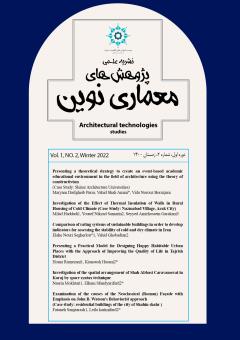Investigation of the Effect of Thermal Insulation of Walls in Rural Housing of Cold Climate (Case Study: Nazmabad Village, Arak City)
Subject Areas :
milad haddadi
1
![]() ,
Yousef Nikzad Samarin
2
,
Seyyed Amirhossein Garakani
3
*
,
Yousef Nikzad Samarin
2
,
Seyyed Amirhossein Garakani
3
*
1 - Natural Disasters Research Institute Researcher, Urban & Architecture Group, Natural Disasters Research Institute, Tehran, Iran.
2 - Master student in structural engineering, Faculty of Civil Engineering, Shahid Rajaee Teacher Training University, Tehran, Iran.
3 - Associate Professor of Architecture, Faculty of Architecture and Urban Planning, Pardis Branch, Islamic Azad University, Tehran, Iran
Keywords: Insulation, Exterior Walls, Rural Housing, Cold Climate, Thermal Comfort.,
Abstract :
Rural housing under the livelihood influence has characteristics that distinguish it from urban housing. The most significant point in contemporary architecture is the excessive use of non-renewable energies. The main reason for this is the lack of desirable design regardless of climatic conditions. Therefore, the correct utilization of local materials in rural areas such as renewable energy can improve thermal comfort conditions. One of the important issues in saving energy in rural areas is that rural settlements face additional problems, including lack of access to the gas network, fuel supply costs, fuel transportation maintenance risks, and electricity costs. In this study, the effectiveness of wall insulation in the cold climate of rural housing is investigated in Markazi province. In the meantime, according to the living conditions, the insulation of walls exposed to heat exchange should be considered a first step. Therefore, the purpose of this study, apart from optimizing external walls, is to consider thermal comfort. In this research, the principle is to examine the energy consumption of rural housing in the desired area without imposing excessive costs, with the most basic solutions.
1- پوردیهیمی، ش.، و گسیلی، ب. (1394). بررسي شناسههای حرارتي جدارههای پوسته خارجي بنا (مطالعه موردی: مناطق روستايي اردبيل). مسکن و محیط روستا، 34 (150)، 53-70.
2- تحصیل¬دوست، م. (1399). بهسازی گونههای مسکن روستایی از دیدگاه انرژی و آسایش حرارتی. مسکن و محیط روستا، 38 (167)، 3-18.
3- خراباتی، س.، و شیرازی، پ (1400). دستیابی به الگوی طراحی مسکن روستایی؛ مطالعۀ موردی: روستای طزره دامغان. مسکن و محیط روستا، 40(175)، 3-18.
4- رازجويان، م. (1388). آسايش بهوسیله معماري همساز با اقليم. تهران: انتشارات دانشگاه شهيد بهشتي.
5- شمس، م.، و خداکرمی، م (1389). بررسي معماري سنتي همساز با اقليم سرد مطالعه موردي: شهر سنندج. آمایش محیط، 3 (10)، 91-114.
6- طاهباز، م.، و جليليان، ش. (1395). صرفهجويي انرژي در مسکن بومآورد روستاهاي استان سمنان. مسکن و محیط روستا، 35 (153)، 3-22.
7- مبحث نوزدهم مقررات ملي ساختمان، صرفه¬جويي در مصرف انرژي (ويرايش دوم)، وزارت مسكن و شهرسازي، معاونت نظام مهندسي و اجراي ساختمان، 1390.
8- مهلبانی گرجی، ی و سنایی، ا. (1389). معماري همساز با اقليم روستاي کندوان. مسکن و محیط روستا، 29(129)، 2-19. تهران: بنياد مسكن انقلاب اسلامی.
9- McKeogh, S. (2005). Rural housing and sustainable.
10- Nikolopoulou, M., Baker, N., & Steemers, K. (2001). Thermal comfort in outdoor urban spaces: understanding the human parameter. Solar energy, 70(3), 227-235.
11- Scudo, G., & Dessì, V. (2006). Thermal comfort in urban space renewal. Proceeding 23th PLEA.

